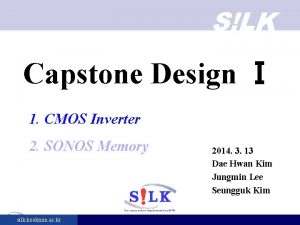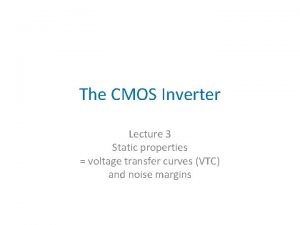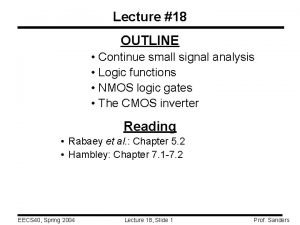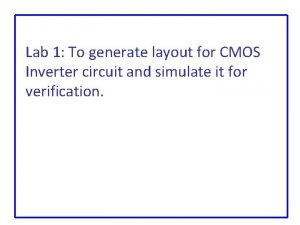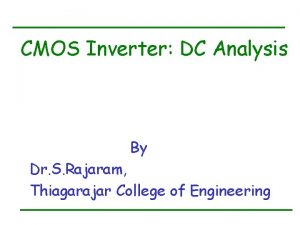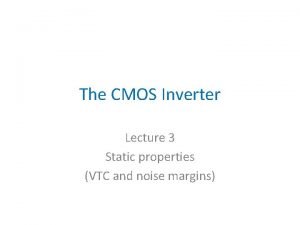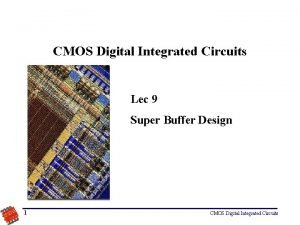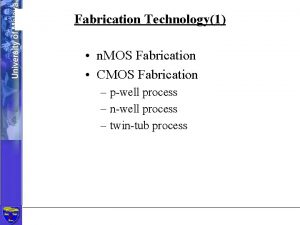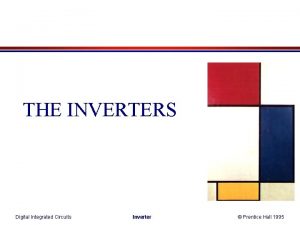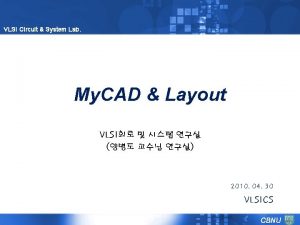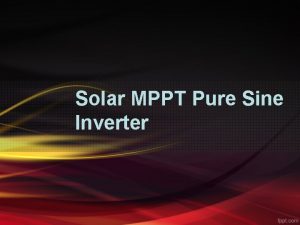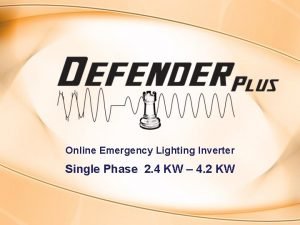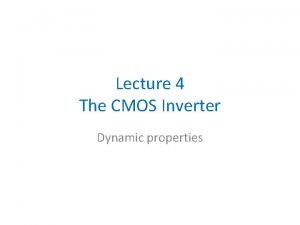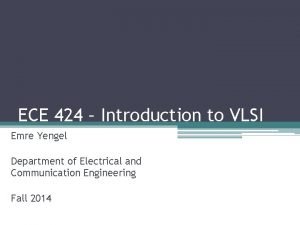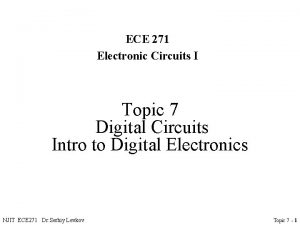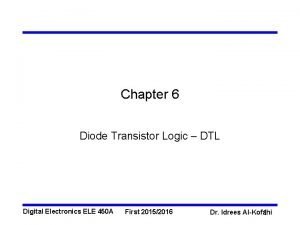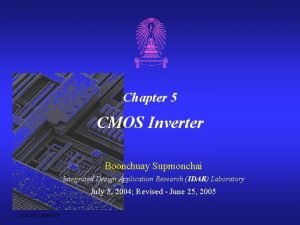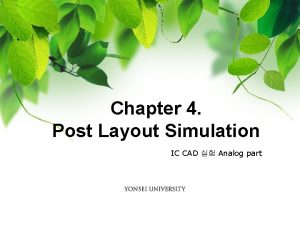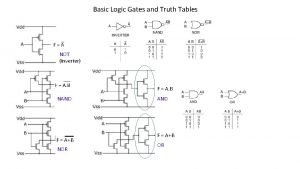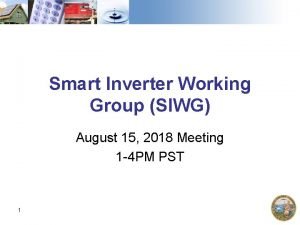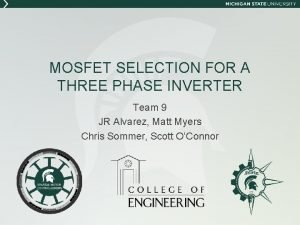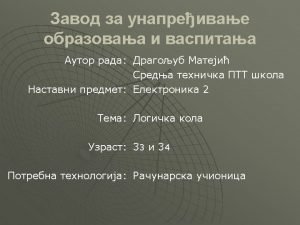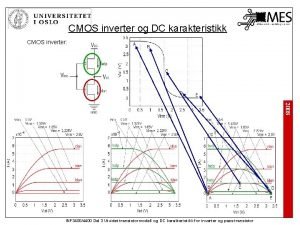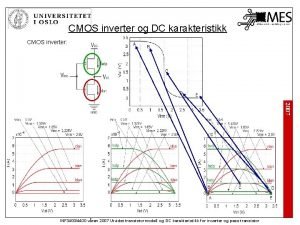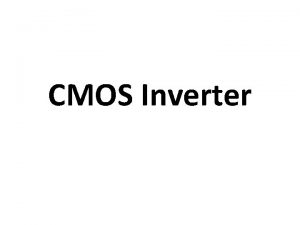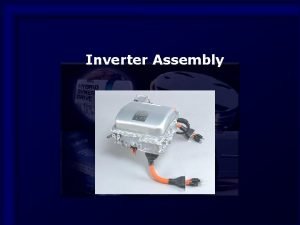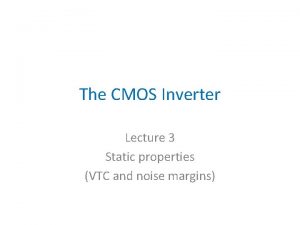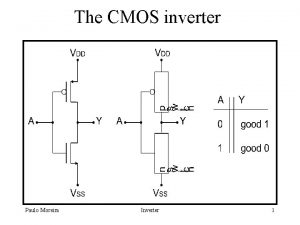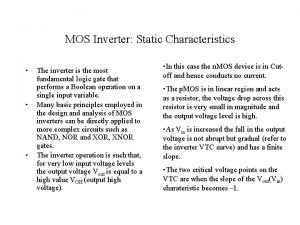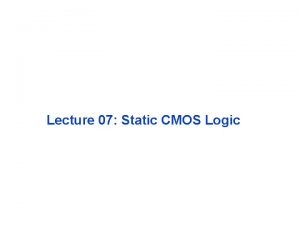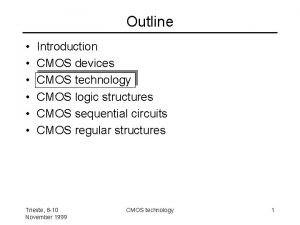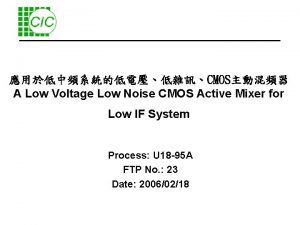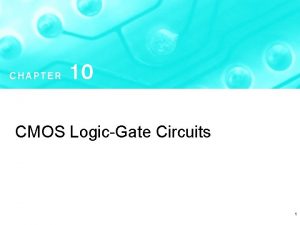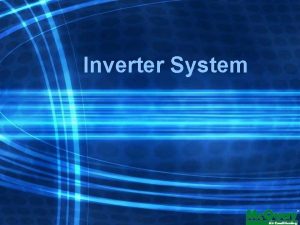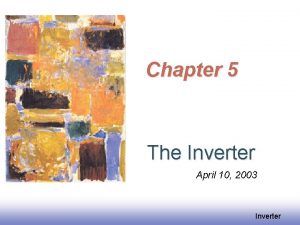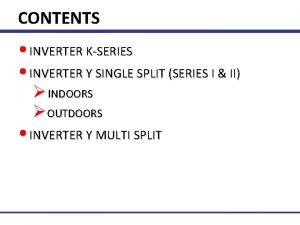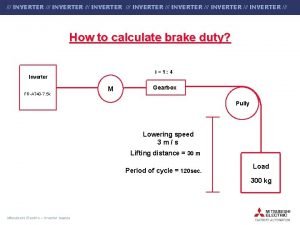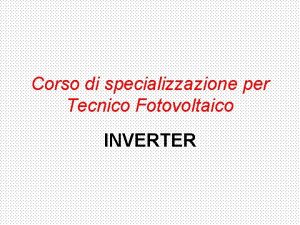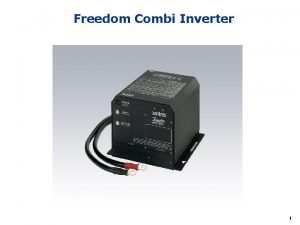The CMOS Inverter Lecture 3 Static properties voltage



































- Slides: 35

The CMOS Inverter Lecture 3 Static properties = voltage transfer curves (VTC) and noise margins

Week 2: The CMOS inverter • Tuesday – Static properties • Voltage transfer curves (VTC) • Noise margins – Exercise (Kjell, 1 hour) • Thursday – Dynamic properties • Propagation delay • Driving large capacitive loads w. optimal propagation delay – Exercise POTW (Victor, 2 hours) • Friday – Prelab 1 deadline 1 PM 2018 -09 -11 MCC 092 IC Design - Lecture 3: The Inverter 2

What happened last week? • Let’s do a quiz about the transistor: – Go to socrative. com – Select Student login – Go to room: “MCC 0922018” 2018 -09 -11 MCC 092 IC Design - Lecture 3: The Inverter 3

Where are we? Inverter Logic gates P-type pull-up network P OUT IN IN N Designing w switches 2018 -09 -11 OUT N-type Pull-down network Hands-on lab session MCC 092 IC Design - Lecture 3: The Inverter 4

Where are we? Inverter Logic gates P-type pull-up network 1 0 OUT IN N-type Pull-down network Designing w switches 2018 -09 -11 Hands-on lab session MCC 092 IC Design - Lecture 3: The Inverter 2

Where are we? Inverter Logic gates P-type pull-up network 0 1 OUT IN N-type Pull-down network Designing w switches 2018 -09 -11 Hands-on lab session MCC 092 IC Design - Lecture 3: The Inverter 2

Where are we? Inverter VSW IDS Logic gates P-type pull-up network VSW OUT IN N-type Pull-down network Designing w switches 2018 -09 -11 Hands-on lab session MCC 092 IC Design - Lecture 3: The Inverter 2

MOSFET I/V Characteristics IDS ON Saturation: IDSN=IDSAT, N IDSN=GONVDS OFF: IDS=0 VDS IDSP=GONVDS Saturation: IDSP=IDSAT, P 2018 -09 -11 ON MCC 092 IC Design - Lecture 3: The Inverter 3

MOSFET I/V Characteristics IDS ON Saturation: ISDP=IDSAT, P ON ISDP=GONVSD OFF: IDS=0 2018 -09 -11 Saturation: IDSN=IDSAT, N IDSN=GONVDS OFF: IDS=0 MCC 092 IC Design - Lecture 3: The Inverter VDS 3

MOSFET I/V Characteristics IDS ON Saturation: IDSN=IDSAT, N Saturation: IDSP=IDSAT, P IDSN=GONVDS OFF: IDS=0 2018 -09 -11 MCC 092 IC Design - Lecture 3: The Inverter VDS 3

VIN/VOUT voltage plane VOUT VDD, VDD NMOS OFF NMOS VIN PMOS OFF VDD PMOS 2018 -09 -11 MCC 092 IC Design - Lecture 3: The Inverter 4

VIN/VOUT voltage plane NMOS OFF VDD, VDD PMOS OFF VOUT VDD 2018 -09 -11 MCC 092 IC Design - Lecture 3: The Inverter VIN 5

Voltage Transfer Characteristic - VTC Inverter VDD 0 NMOS OFF IDS, P=0 1 IDS, N=0 VDD, VDD PMOS OFF VOUT IDS VDD VIN The ON p-switch pulls the output high VDS 2018 -09 -11 MCC 092 IC Design - Lecture 3: The Inverter 6: 1

Voltage Transfer Characteristic - VTC Inverter VDD 1 NMOS OFF IDS, P=0 0 IDS, N=0 VDD, VDD PMOS OFF VOUT IDS VDD VIN The ON n-switch pulls the output low VDS 2018 -09 -11 MCC 092 IC Design - Lecture 3: The Inverter 6: 2

An aside about MOSFET current equations Shockley’s continuous model: Our piecewise linear model: 2018 -09 -11 MCC 092 IC Design - Lecture 3: The Inverter 15

So with piecewise linear MOS model the inverter diagram is this: Notice different slopes between green and blue regions! Transition voltage is VGT/2 rather than VGT 2018 -09 -11 MCC 092 IC Design - Lecture 3: The Inverter 16

Voltage Transfer Characteristic - VTC Inverter IDS NMOS OFF VSW VDD, VDD PMOS OFF VOUT IDS VDD VIN The ON n-switch pulls the output low VDS 2017 -09 -05 MCC 092 IC Design - Lecture 3: The Inverter 6: 2

Voltage Transfer Characteristic - VTC Inverter IDS NMOS OFF VSW VDD, VDD PMOS OFF VOUT IDS VDD VIN Switching occurs in the green region where both MOSFETs are saturated. . . and saturation currents are equal: Saturation: IDSP, N=IDSAT, P VDS 2017 -09 -05 Switching means: VIN=VOUT Solving for VIN using x=k. N/k. P yields MCC 092 IC Design - Lecture 3: The Inverter 6: 3

Voltage Transfer Characteristic - VTC Inverter IDS VSW NMOS OFF VSW VDD DV VSW PMOS OFF VOUT IDS VDD VIN The switching voltage equation Saturation: IDSP, N=IDSAT, P can be rewritten on a form easier to grasp if we introduce VDS 2017 -09 -05 MCC 092 IC Design - Lecture 3: The Inverter 6: 4

Voltage Transfer Characteristic - VTC Inverter IDS NMOS OFF VSW VDD, VDD PMOS OFF VOUT IDS VDD VIN Equal currents in top blue region where p-MOSFET is in linear region yields VOUT vs. VIN! VDS 2017 -09 -05 MCC 092 IC Design - Lecture 3: The Inverter 6: 5

Voltage Transfer Characteristic - VTC Inverter IDS NMOS OFF VSW VDD, VDD PMOS OFF VOUT IDS VDD VIN Equal currents in bottom blue region where n-MOSFET is linear region yields VOUT vs. VIN! VDS 2017 -09 -05 MCC 092 IC Design - Lecture 3: The Inverter 6: 6

The voltage characteristic (VTC) VOUT For x=k. N/k. P=1 we have VDD What if we make n-channel MOSFET wider, i. e. for x>1? What happens to VTC? Will switching voltage VSW increase or decrease? Assume x=4 and we have Assume x=1/4 and we have 0 2018 -09 -11 0 VTN VSW MCC 092 IC Design - Lecture 3: The Inverter VDD+VTP VDD VIN 7

The voltage characteristic (VTC) Which VTC is NAND and which VTC is NOR? Assume all transistor same width VOUT VDD NAND NOR 0 2018 -09 -11 0 VTN VSW MCC 092 IC Design - Lecture 3: The Inverter VDD+VTP VDD VIN 8

The voltage characteristic (VTC) VOUT How about current n-channel MOSFET saturated for VIN<VSW flow? No current flow in red VDD regions! ”short-circuit” current ISC flows in blue/green regions p-channel MOSFET saturated for VIN>VSW 0 2018 -09 -11 0 VTN VSW MCC 092 IC Design - Lecture 3: The Inverter VDD+VTP VDD VIN 9

Noise margins • What are they? • Why are they important? Answers the question: How much noise can the circuit tolerate? 2018 -09 -11 MCC 092 IC Design - Lecture 3: The Inverter 25

Noise Margins - preliminairies VOUT VDD Let´s define valid VOH, min input and output voltage regions from points where slope of VTC is -1; Valid ” 1” That is where AV = -1! AV is the voltage gain. VOL, max Valid ” 0” 0 0 2018 -09 -11 VIL, max VIH, min MCC 092 IC Design - Lecture 3: The Inverter VDD VIN 14

Noise margins - NMH VDD Valid ” 1” VDD VIN VOUT VOH, min VIL, max Valid ” 1” Valid ” 0” VIN not valid NMH VOL, max Valid ” 0” VIL, max 2018 -09 -11 VIH, min VIN MCC 092 IC Design - Lecture 3: The Inverter 10 VOUT 0

Noise Margins- NML VDD Valid ” 1” VDD VIN VOUT VIL, max NML VIH, min Valid ” 1” VIN not valid VOH, min VOL, max 0 VIL, max 2018 -09 -11 VIH, min VIN MCC 092 IC Design - Lecture 3: The Inverter 11 VOUT 0 Valid ” 0”

Regenerative effect = How well the signal is regenerated from input to output f(VIN) Consider a pair of cross-coupled inverters VIN that is VOUT g(VOUT) We take the partial derivate of this function w. r. t VIN (using the chain rule): Slopes, that is, small-signal gains So we see that the inverse of f (the VTC) is g in each pair of corresponding voltage points. Only if the VTC has a region of gain magnitude > 1 bordered by two regions of gain magnitude < 1 is the circuit regenerative. Then there are two stable operating points. The VTC and its inverse are illustrated in the butterfly diagram. 2018 -09 -11 MCC 092 IC Design - Lecture 3: The Inverter 29

Butterfly Diagram In each pair of corresponding voltage points (VIN, VOUT) the product of the derivatives (that is the small-signal gains) of the two curves is 1 VOUT The points where both gains are -1 defines the voltages of interest for noise margins VDD Valid ” 1” VOH, min Memory cell characterization NMH VIN VOUT VTC, that is f NML 0 Valid ” 0” 0 VIL, max 2018 -09 -11 VIH, min Inverse of VTC, that is g VOL, max See W&H section 12. 2. 1. 3 for more info if you want to. VIN MCC 092 IC Design - Lecture 3: The Inverter 12

Noise Margins – skewed inverters NMH NML 2018 -09 -11 NMH MCC 092 IC Design - Lecture 3: The Inverter 13

Noise Margins – an example Let´s define valid regions from points where slope AV = -1! VOUT NMH=VOH, min-VIH, min NML=VIL, max- VOL, max These points yields VDD numbers for VOH, min (VOH, min, VIL, max) and (VOL, max, VIH, min) so that NMH and NML can be calculated! Valid ” 1” VOL, max 0 2018 -09 -11 Valid ” 0” 0 VIL, max VIH, min MCC 092 IC Design - Lecture 3: The Inverter VDD VIN 14

Noise Margins – an example Let´s define valid regions from points where slope AV = -1! NMH=VOH, min-VIH, min 1. 12 -0. 68=0. 44 V NML=VIL, max- VOL, max = 0. 52 -0. 08=0. 44 V VOUT DV=0. 64 V 0. 28 V These points yields VDD numbers for VOH, min (VOH, min, VIL, max) and (VOL, max, VIH, min) so that NMH and NML can be calculated! For x=1, VTN=0. 28 V and VTP=-0. 28 V we have VSW=0. 28+0. 64/2=0. 60 V and DV=0. 64 V Formulas can be derived (for x=1): VOH, min=VDD-DV/8=1. 12 -DV/8 V VOL, max = DV/8=80 DV/8 m. V VOL, max VIL, max=VSW-DV/8=0. 52 -DV/8 V 0 VIH, min=VSW+DV/8=0. 68 +DV/8 V 2018 -09 -11 Valid ” 1” DV/8 VDD = 1. 2 V DV/8 Valid ” 0” 0 0. 28 V VIL, max VIH, min MCC 092 IC Design - Lecture 3: The Inverter VDD VIN 15

What about lab 1 • Calculate VSW and find from simulation in lab • Calculate noise margins and find from simulation 2018 -09 -11 MCC 092 IC Design - Lecture 3: The Inverter 34

Summary • CMOS inverter – schematic • Voltage transfer characteristics (VTC) – Regions of operation – How to calculate switching voltage VSW – VSW dependence on k. N/k. P (that is, transistor widths) – Understand switching current (ISC) flow • Noise margins: NMH and NML – Why important? – Definition – Butterfly diagram 2018 -09 -11 MCC 092 IC Design - Lecture 3: The Inverter 16
 Cmos short circuit current
Cmos short circuit current Cmos inverter vtc
Cmos inverter vtc Cmos inverter small signal model
Cmos inverter small signal model Microwind cmos inverter
Microwind cmos inverter Dc characteristics of cmos inverter
Dc characteristics of cmos inverter Cmos inverter vtc
Cmos inverter vtc In cmos inverter super buffers have
In cmos inverter super buffers have Pwell
Pwell Digital inverter
Digital inverter Cmos vlsi design lecture notes
Cmos vlsi design lecture notes Static power dissipation in nmos inverter
Static power dissipation in nmos inverter Medium voltage
Medium voltage Applications of ac voltage controller
Applications of ac voltage controller Line vs phase voltage
Line vs phase voltage Volt peak to peak to rms
Volt peak to peak to rms The objective of earthing or grounding is
The objective of earthing or grounding is 01:640:244 lecture notes - lecture 15: plat, idah, farad
01:640:244 lecture notes - lecture 15: plat, idah, farad Inverter compressor troubleshooting
Inverter compressor troubleshooting Lvs in vlsi
Lvs in vlsi Que es la tecnologia inverter
Que es la tecnologia inverter Eaton true sine wave inverter controller
Eaton true sine wave inverter controller Online lighting inverter
Online lighting inverter Ideal inverter
Ideal inverter Nmos inverter with depletion load
Nmos inverter with depletion load Ece 271
Ece 271 Eaton inverter 1800w
Eaton inverter 1800w Dtl logic
Dtl logic Inverter layout
Inverter layout Cadence inverter layout
Cadence inverter layout Inverter truth table
Inverter truth table Transistor signal inverter
Transistor signal inverter Battery inverter
Battery inverter Common smart inverter profile
Common smart inverter profile Mosfet package types
Mosfet package types Timing diagram for and gate
Timing diagram for and gate Rtl inverter
Rtl inverter
